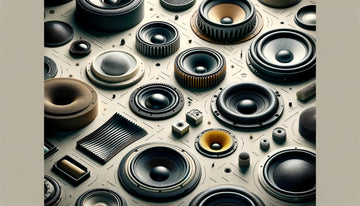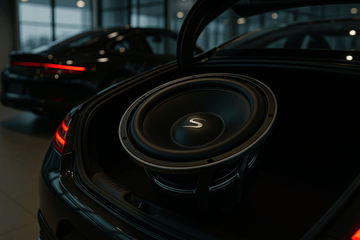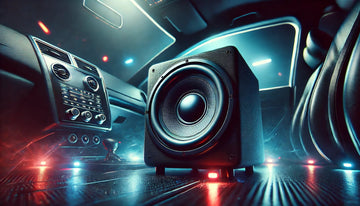Regarding car audio systems, the subwoofer plays a crucial role in delivering high-quality sound. At the heart of the subwoofer lies the speaker cone. The cone material of a subwoofer is responsible for producing low-frequency sounds, adding depth and richness to your audio experience. With a wide variety of cone materials available, it's essential to understand their characteristics and how they impact sound quality.
In this blog, we will dive into Comparing Subwoofer Cone Materials, looking at their strengths and weaknesses while discussing factors to consider when choosing the suitable material for your car audio system.
Get an in-depth analysis of subwoofer materials and their impact on sound. Explore our Car Subwoofer Materials article.
The Role and Importance of Speaker Cone Materials
The cone material of a speaker is crucial for sound quality. It affects the speaker's ability to move air and produce sound waves. Different cone materials have varying characteristics influencing tonal qualities, frequency response, and overall sound performance. Understanding speaker cones and cone materials helps us make informed choices to enhance our audio experience.
Understanding the Basics of Speaker Cones
Speaker cones create pistonic motion to reproduce sound waves accurately. The choice of cone material directly impacts the speaker's ability to achieve perfect pistonic motion and faithful sound reproduction. It also helps minimize unwanted frequencies and resonances for a cleaner sound. Selecting the suitable cone material is essential for optimizing speaker systems and achieving high-quality sound reproduction.
Importance of Cone Materials in Sound Quality
Cone materials significantly contribute to the sound characteristics of a speaker system. Each material has advantages and disadvantages, influencing tonal qualities, environmental resistance, and frequency response. Understanding how cone materials interact with other subwoofer components, such as voice coils and enclosures, allows audio enthusiasts to fine-tune their systems for ideal sound reproduction.
Discussing Different Subwoofer Cone Materials:
When evaluating car subwoofer cone materials, it's essential to consider their real-world performance. The soft cone of a woofer can impact its overall sound quality and durability, making it a crucial factor to examine. Choosing the suitable material can significantly affect the audio output and longevity of the subwoofer, ensuring an optimal listening experience.
Paper Cones: Pros and Cons
Paper cones have been famous for subwoofer cone materials for many years. They provide a natural sound reproduction with a warm tonal quality, making them ideal for home theater audio systems. Paper cones are relatively lightweight, allowing for low mass and high-end response. However, they may not be moisture-resistant, making them less suitable for car audio applications. Some advantages of paper cones include:
- Natural sound reproduction
- Warm tonal qualities
- Low mass for high-end response
- However, there are some drawbacks to paper cones, including:
- Lack of moisture resistance
- Limited suitability for car audio**
Polypropylene Cones: Advantages and Disadvantages
Polypropylene cones are famous in car audio systems due to their moisture resistance and durability. They can withstand temperature changes, making them ideal for harsh environments. While they offer a comprehensive frequency response, they may not provide the same stiffness and high-end response as other materials. Advantages of polypropylene cones include:
- Moisture resistance
- Durability in harsh environments
- Wide frequency response
- However, there are some drawbacks to polypropylene cones, including:
- Potential lack of stiffness
- Limited high-end response**
Kevlar Cones: Strengths and Weaknesses
Made from aramid fiber, Kevlar cones offer high stiffness and excellent moisture resistance. They are known for their durability and ability to deliver tight, accurate bass. Kevlar cones provide a balanced tonal response, making them suitable for various car audio applications. However, kevlar cone materials may come at a higher cost than other materials. Some advantages of kevlar cones include:
- High stiffness
- Excellent moisture resistance
- Accurate, tight bass response
- However, there may be some drawbacks to kevlar cones, including:
- Higher cost compared to other cone materials**
Metal Cones: Benefits and Drawbacks
Often made from aluminum, metal cones offer unique benefits for subwoofer cone materials. They are known for their high stiffness, allowing for efficient sound reproduction at high speeds. Metal cones provide excellent frequency response and tonal characteristics, ideal for high-end sound systems. However, they may not be as common in car audio applications and can be more expensive than other materials. Some benefits of metal cones include:
- High stiffness for efficient sound reproduction
- Excellent frequency response
- Ideal for high-end sound systems
- However, there may be some drawbacks to metal cones, including:
- Less common in car audio applications
- Higher cost compared to other materials**
Analyzing Carbon Fiber Cones
Carbon fiber cones balance stiffness and are lightweight, making them ideal for high-performance audio systems. They provide high stiffness, ensure piston motion at high speeds, and offer excellent tonal characteristics. Carbon fiber cones are often reinforced with carbon black, enhancing their stiffness and damping properties. However, carbon fiber cones can be more expensive compared to other materials. Some advantages of carbon fiber cones include:
- Lightweight
- High stiffness for ideal pistonic motion
- Excellent tonal characteristics
- However, carbon fiber cones may cost more than other cone materials.
Comparison Between Paper Cone and Polypropylene Speakers
When comparing paper cones and polypropylene cones, both have their strengths and weaknesses. Paper cones provide warm tonal qualities for home theater audio systems, while polypropylene cones offer moisture resistance and durability for car audio applications. The choice depends on personal preferences and desired sound characteristics.
Factors to Consider When Choosing Cone Material:
When selecting cone material, it's crucial to consider the real-world performance. The soft cone materials provide accurate and smooth sound reproduction, making them ideal for car audio systems. Additionally, the quality of the woofer dramatically depends on the selected cone material, affecting the overall audio experience.
Considering Environmental Resistance
Environmental resistance is an essential factor to consider when selecting cone materials, particularly for car audio applications. Cone materials with high moisture resistance, such as polypropylene and kevlar, ensure longevity and durability, even in challenging environmental conditions. Additionally, cone materials should withstand temperature changes, maintaining optimal sound performance.
Balancing Flexibility and Rigidity
The ideal cone material should strike a balance between flexibility and rigidity. High stiffness ensures pistonic motion, minimizing unwanted frequencies and optimizing bass response. Lightweight cone materials, such as carbon fiber, offer high stiffness while keeping mass low, allowing for more excellent response at high volumes. When choosing cone materials, it's crucial to prioritize perfect pistonic motion and tonal qualities while considering material weight and rigidity.
Interaction of Cone Material with Other Subwoofer Components:
When considering the interaction of cone material with other subwoofer components, it's essential to assess its real-world impact. The soft cone can significantly affect the woofer's performance, leading to sound quality and resonance variations. Understanding how these elements work together provides valuable insights for optimizing audio output.
How Cone Material Influences Voice Coils
The stiffness of the cone material directly affects the pistonic motion of the voice coil, significantly impacting sound quality. Aluminum cones, for example, provide high stiffness, allowing for efficient pistonic motion and accurate sound reproduction. The choice of cone material should consider its interaction with the voice coil to ensure optimal system performance, especially in reproducing midrange frequencies.
Cone Material's Impact on Different Subwoofer Enclosures
Subwoofer cone materials interact differently with various subwoofer enclosure types, such as ported and sealed enclosures. The choice of cone material should consider how it impacts internal damping within different enclosures, affecting sound quality and bass response. Subwoofer cone materials should be selected to optimize performance within specific enclosure designs, maximizing sound system capabilities.
FAQs on Subwoofer Cone Materials
As we wrap up our exploration of subwoofer cone materials, let's address some frequently asked questions to enhance your understanding of cone material selection further.
Commonly Used Subwoofer Cone Materials
The most common subwoofer cone materials include paper, plastic, carbon fiber, kevlar, and metal cones. Each material offers unique advantages, catering to different audio system requirements and personal preferences. The choice of cone material depends on sound characteristics, environmental resistance, and durability.
Effect of Cone Material on Subwoofer Longevity
The cone material used in subwoofers is crucial for their longevity. Polypropylene, kevlar, and carbon fiber provide moisture resistance and durability, ensuring long-lasting performance even in challenging conditions. Subwoofer systems with cones with high stiffness and environmental resistance maintain sound quality and performance over time.
Is it Possible to Replace My Subwoofer's Cone With a Different Material?
Replacing a subwoofer's cone material can alter the system's sound characteristics, frequency response, and bass characteristics. It is possible to replace a subwoofer's cone with a different material. Still, this decision should be made carefully considering environmental resistance, stiffness, and sound characteristics. Different cone materials offer unique advantages, impacting the real-world performance of the subwoofer system.
Conclusion
Choosing subwoofer cone material is crucial for your car audio system's sound quality and performance. Each material has its advantages and disadvantages. Consider environmental resistance, flexibility, rigidity, and its interaction with other components. While replacing the cone with a different material is possible, consulting a professional is recommended. Choose the right subwoofer cone for optimal sound reproduction and an immersive listening experience.





